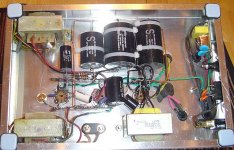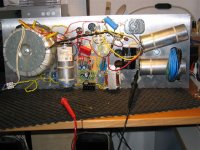I don'y understand. Is it possible to build a circuit whithout a PCB?
How? With wires?
Forgive me for these naive questions, but I dont know many thing about amps with lamps.
How? With wires?
Forgive me for these naive questions, but I dont know many thing about amps with lamps.
In that case
You should learn the most essential things first before you act. Especially because you deal with high voltages. You should first orient bij reading. You can begin with the permanent threads on top of this forum. Perhaps you can buy a book although most books are not suited for beginners or are written by engineers which means they are useless 😉 Understanding has nothing to do with formulas. Look for pictures if you want to see how other people built without a PCB.
Next thing is buying a kit. Best learning can be done by experience. You have to learn to solder for instance. Keep reading the forums and then you will get ideas of changing your kit.
Next level is to built an amp on your own. You can copy a design from other people. Built something with an el84 tube.
So your next question could be, what kit should I choose ?🙁
Well if you do a search on this forum you should find the answers on this one.
🙂
You should learn the most essential things first before you act. Especially because you deal with high voltages. You should first orient bij reading. You can begin with the permanent threads on top of this forum. Perhaps you can buy a book although most books are not suited for beginners or are written by engineers which means they are useless 😉 Understanding has nothing to do with formulas. Look for pictures if you want to see how other people built without a PCB.
Next thing is buying a kit. Best learning can be done by experience. You have to learn to solder for instance. Keep reading the forums and then you will get ideas of changing your kit.
Next level is to built an amp on your own. You can copy a design from other people. Built something with an el84 tube.
So your next question could be, what kit should I choose ?🙁
Well if you do a search on this forum you should find the answers on this one.
🙂
aetosa said:I don'y understand. Is it possible to build a circuit whithout a PCB?
How? With wires?
Forgive me for these naive questions, but I dont know many thing about amps with lamps.
Yeap !
Some do MUCH MORE clean job than me

Yves.
That looks like a nice construction to me. Small and neat; no unnecessary wires. The only comment I would make is that rotating all the transformers through 90 degrees would avoid the mains transformer squirting flux into the audio department.
aetosa said:I don'y understand. Is it possible to build a circuit whithout a PCB?
How? With wires?
Called point-to-point. This example is a couple transformers more complex than the simpliest 2 stage you can build... the power supply is more complicated than the audio part....
dave
Attachments
those wires
come from the amplimo toroid OPT which is on top.
The amp is 2A3se with ecc40 beta follower (with current diode between top and bottom half) as a driver. design Martin Huber
come from the amplimo toroid OPT which is on top.
The amp is 2A3se with ecc40 beta follower (with current diode between top and bottom half) as a driver. design Martin Huber
bal input
hi there,
can this el84 amp be used with bal inputs?
Do you really need 63V caps in the bias of el84s?
/Axel
hi there,
can this el84 amp be used with bal inputs?
Do you really need 63V caps in the bias of el84s?
/Axel
There's only 11V on the cathodes, but if you look up the manufacturer's data, you'll see that the ESR for 63V capacitors is usually lower than for 16V.
Update on the 6V6 version - Screen resistors reduced from 1K to 220R. I thought it made a worthwhile improvement - amp sounded tighter.
Cheers,
Ian
Cheers,
Ian
More Mods to 6V6 version
Newest fine tune mods to the 6V6 amp.
1) reduce coupling caps to 100nF - Its pointless coupling heaps of subsonic signal, all you do is help saturate the output transformers. The 100nF shifts -3dB lower frequency from 7.2Hz up to 16Hz.
2) Ditch the zobels from anode to screen taps of the output transformer. The ones shown are far too agressive. I may work out some new ones later BUT for now just get rid of them.
3)Push up the local shunt feedback - increase that 13K cross coupling resistor to 20K. This gets Zout down to 2.1 Ohms with zero global feedback and tightens the amp (speaker dependent). Note that this is a great resistor sound test bed. I found noticable differences in sound with various types of resistor (of the same value) in this circuit position.
Cheers,
Ian
Newest fine tune mods to the 6V6 amp.
1) reduce coupling caps to 100nF - Its pointless coupling heaps of subsonic signal, all you do is help saturate the output transformers. The 100nF shifts -3dB lower frequency from 7.2Hz up to 16Hz.
2) Ditch the zobels from anode to screen taps of the output transformer. The ones shown are far too agressive. I may work out some new ones later BUT for now just get rid of them.
3)Push up the local shunt feedback - increase that 13K cross coupling resistor to 20K. This gets Zout down to 2.1 Ohms with zero global feedback and tightens the amp (speaker dependent). Note that this is a great resistor sound test bed. I found noticable differences in sound with various types of resistor (of the same value) in this circuit position.
Cheers,
Ian
Bigger caps result in less phase error at low frequencies though...1) reduce coupling caps to 100nF - Its pointless coupling heaps of subsonic signal, all you do is help saturate the output transformers. The 100nF shifts -3dB lower frequency from 7.2Hz up to 16Hz.
Steve
Bigger caps result in less phase error at low frequencies though...
IN his heretycal linestage thread SY defends the use of a very small (10nF) capacitor in front of the cathode follower (with it's input impedance of 20M ohms). If I am right (and I am not always right) he argues that, if you have to use a capacitor, you use a small one, because its building properties are better.
Erik
I agree completely, and 10nF is silvered mica territory, but it is the input impedance of 20MW that allows the use of only 10nF. But if the low value causes overall phase error performance problems..... I'm not sure. Depends how much your chosen listening material relies on good LF reproduction too I guess, as no doubt smaller caps handle high frequencies better.
Steve
Steve
Erik, that's pretty much it. Less dielectric, smaller structure, lower microphonics, and (purely subjectively) a more open, clean sound.
But 16Hz is indeed an awfully high cutoff for a full range amp. I'd want to keep f3 at least a decade lower than the lowest frequency of interest. In the Heretical, that's in the 1 Hz range. For a midrange or tweeter amp, the higher cutoff frequency would be no problem.
But 16Hz is indeed an awfully high cutoff for a full range amp. I'd want to keep f3 at least a decade lower than the lowest frequency of interest. In the Heretical, that's in the 1 Hz range. For a midrange or tweeter amp, the higher cutoff frequency would be no problem.
In my (albeit limited) experience the one caveat with small coupling caps is grid leak circuits. Very small values present a very high impedance to the grid. That coupled to a circuit with gain results in high susceptibility to noise pickup. In a circuit like the Mullard 3-3 which added global negative feedback to the mix an input cap less than about 50 nF (into a 10 Meg grid leak resistor) resulted in outright instability.
BTW, if you're interested silvered mica is available in values as high as 0.2 uF. Check E-bay.
BTW, if you're interested silvered mica is available in values as high as 0.2 uF. Check E-bay.
Power Transformer
I like the EL84 version, but as I'm a pretty big newbie too, I'm wondering about a power transfomer - specifically, how much current does the HT supply need?
Would a Hammond 270X which can supply 40mA (240-0-240) be sufficient? I'm just guessing that it wouldn't, but could anyone recommend a power transformer that might?
thanks,
Jeremy
I like the EL84 version, but as I'm a pretty big newbie too, I'm wondering about a power transfomer - specifically, how much current does the HT supply need?
Would a Hammond 270X which can supply 40mA (240-0-240) be sufficient? I'm just guessing that it wouldn't, but could anyone recommend a power transformer that might?
thanks,
Jeremy
- Home
- Amplifiers
- Tubes / Valves
- EL84 Amp - Baby Huey

